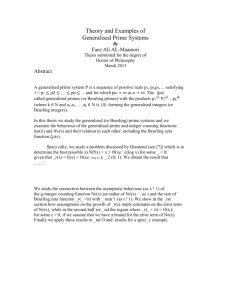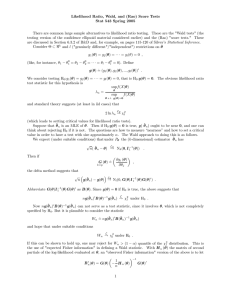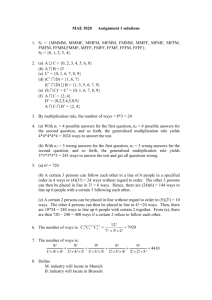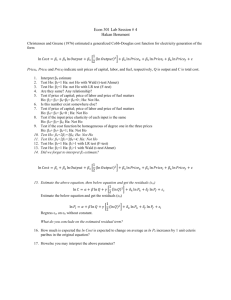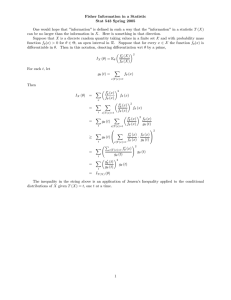Document 10909074
advertisement
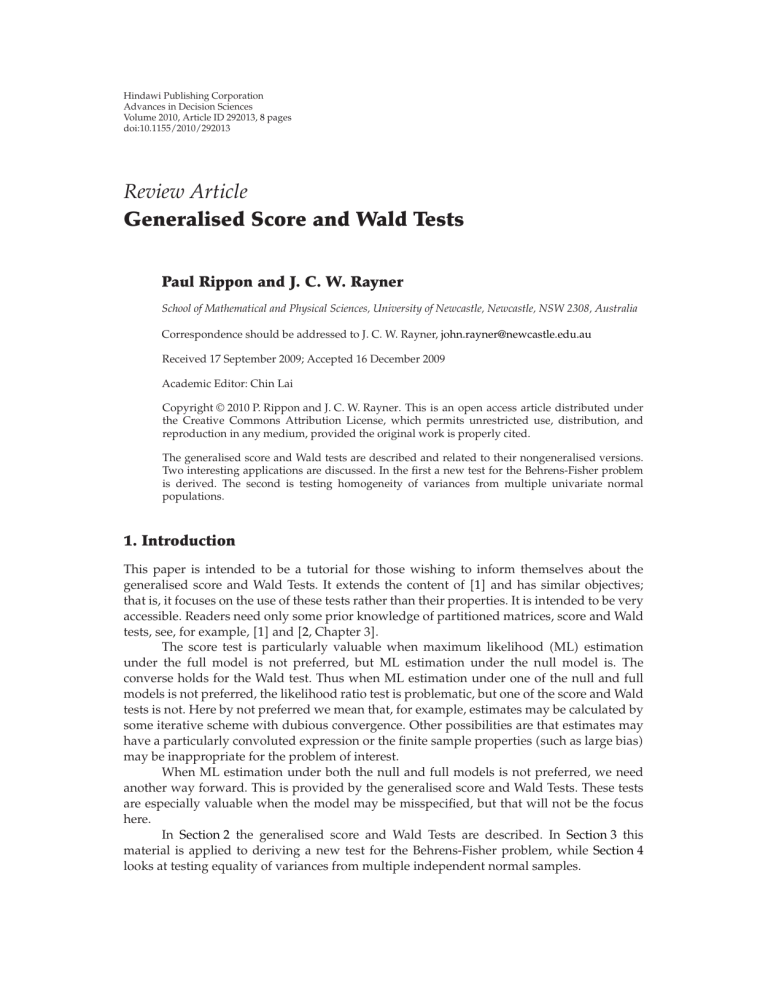
Hindawi Publishing Corporation
Advances in Decision Sciences
Volume 2010, Article ID 292013, 8 pages
doi:10.1155/2010/292013
Review Article
Generalised Score and Wald Tests
Paul Rippon and J. C. W. Rayner
School of Mathematical and Physical Sciences, University of Newcastle, Newcastle, NSW 2308, Australia
Correspondence should be addressed to J. C. W. Rayner, john.rayner@newcastle.edu.au
Received 17 September 2009; Accepted 16 December 2009
Academic Editor: Chin Lai
Copyright q 2010 P. Rippon and J. C. W. Rayner. This is an open access article distributed under
the Creative Commons Attribution License, which permits unrestricted use, distribution, and
reproduction in any medium, provided the original work is properly cited.
The generalised score and Wald tests are described and related to their nongeneralised versions.
Two interesting applications are discussed. In the first a new test for the Behrens-Fisher problem
is derived. The second is testing homogeneity of variances from multiple univariate normal
populations.
1. Introduction
This paper is intended to be a tutorial for those wishing to inform themselves about the
generalised score and Wald Tests. It extends the content of 1 and has similar objectives;
that is, it focuses on the use of these tests rather than their properties. It is intended to be very
accessible. Readers need only some prior knowledge of partitioned matrices, score and Wald
tests, see, for example, 1 and 2, Chapter 3.
The score test is particularly valuable when maximum likelihood ML estimation
under the full model is not preferred, but ML estimation under the null model is. The
converse holds for the Wald test. Thus when ML estimation under one of the null and full
models is not preferred, the likelihood ratio test is problematic, but one of the score and Wald
tests is not. Here by not preferred we mean that, for example, estimates may be calculated by
some iterative scheme with dubious convergence. Other possibilities are that estimates may
have a particularly convoluted expression or the finite sample properties such as large bias
may be inappropriate for the problem of interest.
When ML estimation under both the null and full models is not preferred, we need
another way forward. This is provided by the generalised score and Wald Tests. These tests
are especially valuable when the model may be misspecified, but that will not be the focus
here.
In Section 2 the generalised score and Wald Tests are described. In Section 3 this
material is applied to deriving a new test for the Behrens-Fisher problem, while Section 4
looks at testing equality of variances from multiple independent normal samples.
2
Advances in Decision Sciences
2. M-Estimators and Generalised Score Tests
The class of M-estimators includes both ML and method of moments estimators. An Mestimator γ satisfies
n
Ψ Xj , γ 0p ,
2.1
j1
in which X1 , . . . , Xn are independent but not necessarily identically distributed, Ψ is a known
p × 1 function not depending on j or n, γ is a p-dimensional parameter, and in general 0m
denotes an m × 1 vector of zeros. The estimating function Ψ must be sufficiently ‘smooth.’
In particular, its derivatives up to second order, and their expectations, must exist. Hence
the matrices A and B defined subsequently are assumed to exist. Also, the expectation of
the second-order derivatives must be bounded in probability. More technical details on Mestimators may be found in 3, Chapter 5.
T
In our setting we assume that γ θT , βT and that we wish to test H0 : θ 0k against
the alternative K: θ / 0k with θ being the k × 1 vector of primary interest, with β a q × 1 vector
of nuisance parameters, and with p k q. The generalised score test is based on the partial
M-estimator that satisfies
n
Ψβ Xj , γ0 0q ,
2.2
j1
T
where Ψ is partitioned similarly to γ, so that ΨT ΨTθ , ΨTβ , and where γ0 0Tk , β0T in which
β0 is the M-estimator of β under the null hypothesis. Define
n
Ψθ Xj , γ ,
Uθ γ j1
∂Ψ X, γ
A γ −E0
∂γ
B γ E0 ΨΨT Aθθ Aθβ
Aβθ Aββ
Bθθ Bθβ
Bβθ Bββ
2.3
,
,
in which E0 denotes expectation under the null hypothesis. Here Aγ and Bγ are p × p and
Aθθ and Bθθ are k × k. We note that Aγ is not necessarily symmetric while Bγ is. This
means that the form of the generalised tests given by, for example, 4, needs to be slightly
modified. The generalised score test statistic is given by
SG UθT
A
T
−1 θθ
−1
A B A
T
−1 −1
θθ
A−1
θθ
Uθ
2.4
Advances in Decision Sciences
3
−1
in which, as can readily be shown, A−1 θθ Aθθ − Aθβ A−1
A and the arguments in Uθ ,
ββ βθ
A, and B are suppressed; here all are γ0 . Similarly the generalised Wald test statistic is given
by
WG θT A−1 B AT
−1 −1
θ
2.5
θθ
in which all arguments are γ . In the exposition in 4 parameters are estimated by ML but the
data do not come from the parametric model: this is ML under misspecification. In 5, Kent’s
definitions are given but in place of ML estimators any M-estimators are permitted. It is also
noted in 4 that A and B can in practice be replaced by any consistent estimates.
An alternative form of SG that is more convenient for calculation is given in 2, where
it is applied to the construction of generalized smooth tests of goodness of fit. This form gives
SG UθT γ0 Σ−1
0 Uθ γ0
GS γ
2.6
in which
T
−1
A
B
−
B
ATθβ
ΣGS γ Bθθ − Aθβ A−1
βθ
θβ
ββ
ββ
−1
Aθβ A−1
ββ Bββ Aββ
T
ATθβ .
2.7
The equivalence of the two forms requires routine but tedious matrix algebra and is omitted
here. The asymptotic distribution of both SG and WG under H0 is χ2k .
If ΨX, γ is the derivative of logarithm of the likelihood, which is the usual score
−1
function, then A B is the usual symmetric information matrix, and A−1 BAT A−1 . If
the usual Wald test statistic, and
A }θ,
ML estimation is used, then WG θT {Aθθ − Aθβ A−1
ββ βθ
−1
SG UθT {Aθθ − Aθβ A−1
A } Uθ , the usual score test statistic. Both are given in this form in
ββ βθ
1. For more information see 5, 6.
γ0 in
In 5, page 328 replacing the inverse of the asymptotic covariance matrix ΣGS γ0 is recommended. Although
SG by a generalised inverse of a consistent estimate of ΣGS it may sound trivial, when calculating any of the ordinary or generalised score or Wald
test statistics, we are finding X − EXT Σ−1 X − EX where X is at least asymptotically
multivariate normal and Σ is at least asymptotically the full rank covariance matrix of X.
Very occasionally it may be more convenient to find the exact covariance matrix rather
than one that is asymptotically equivalent. If so the exact covariance matrix can be used in
the above expressions; similarly when appropriate a generalised inverse of the exact or an
asymptotically equivalent covariance matrix can be used.
3. The Behrens-Fisher Problem
In the Behrens-Fisher problem, Y1 , . . . , Ym is a random sample from an NμY , σY2 population,
and Z1 , . . . , Zn is an independent random sample from an NμZ , σZ2 population. It is desired
μZ , with the standard deviations σY and σZ being nuisance
to test H: μY μZ against K: μY /
parameters. In 2, Example 3.3.2 the likelihood ratio, score, and Wald tests are derived. The
score test requires the solution of an inconvenient cubic equation; so this is one situation in
4
Advances in Decision Sciences
which the Wald statistic looks distinctly more appealing than both the likelihood ratio and
score test statistics.
When the estimating function nj1 ΨXj , γ is the usual score function, the generalised
score test is the usual score test. To conform to our notation put Y1 , . . . , Ym , Z1 , . . . , Zn X T ,
0, with
μY − μZ 2θ, μY μZ 2β1 , σY2 β2 and σZ2 β2 . We test H : θ 0 against K : θ /
nuisance parameters β1 , β2 and β3 . The logarithm of the likelihood is
constant −
−1 2 −1 n
m
log β2 −
log β3 − 2β2
yi − β1 − θ − 2β3
zj − β1
2
2
i
j
2
θ ,
3.1
and therefore the score function has the following components:
zj − β1
yi − β1 − θ
Sθ γ −
β2
β3
i
j
θ
zj − β1
β3
j
θ
yi − β1 − θ
Sβ 1 γ β2
i
m
Sβ2 γ − 2β2
yi − β1 − θ 2
,
2
2β2
i
n
Sβ3 γ − 2β3
zj − β1 θ 2
.
2
2β3
j
,
,
3.2
These are the partial derivatives of the logarithm of the likelihood. Under the null hypothesis
the estimating equations are Sβ1 γ0 Sβ2 γ0 Sβ3 γ0 0. This leads to the inconvenient
cubic equation mentioned previously. If we proceed with this model, the cubic must be solved
2
2
to find β10 , and hence β20 Yi − β10 /m and β30 Zj − β10 /n. We also find
i
j
Sθ γ0 ⎛m
2 Y −Z
β20 /m
n m n
−
β3 β2 β3
β30 /n
,
⎞
0
0
⎜ β2
⎟
⎜
⎟
⎜
⎟
⎜m n m n
⎟
⎜ −
⎟
0
0
⎜ β2 β3 β2 β3
⎟
⎜
⎟
⎟ B,
A⎜
⎜
⎟
m
⎜ 0
⎟
0
0
2
⎜
⎟
⎜
⎟
2β2
⎜
⎟
⎜
n ⎟
⎝
⎠
0
0
0
2
2β3
3.3
Advances in Decision Sciences
5
whence
ΣGS 2
β /m
4
3.4
,
β3 /n
2
and the generalised score test statistic is SG Y − Z /β20 /m β30 /n. This is just the
ordinary score test statistic.
While solving the cubic is not a great difficulty, if we modify Sβ1 γ so that it becomes
Sβ1 γ yi − β1 − θ
θ ,
zj − β1
i
3.5
j
a possibly less efficient but certainly more convenient estimator of the common mean under
∗
the null hypothesis may be found. This estimator is the solution to Sβ1 γ0 0, namely, β10
mY nZ/m n. If we also modify Sθ γ so that
Sθ γ yi − β1 − θ −
zj − β1
i
θ ,
3.6
j
while leaving the other two equations unchanged, the generalised score test is based on
2mn
Sθ γ0 Y −Z .
m n
3.7
∗
The estimators of β2 and β3 are slightly different from those found previously, being β20
2
2
∗
∗
∗
i Yi − β10 /m and β30 j Zj − β10 /n. Modifying the previous derivation gives
⎛
m
n m−n
0
0
⎞
⎜
⎟
⎜m − n m n
0
0 ⎟
⎜
⎟
⎜
⎟
⎜
⎟
m
,
A⎜ 0
0
0 ⎟
2
⎜
⎟
2β2
⎜
⎟
⎜
⎟
⎝
n ⎠
0
0
0
2
2β3
⎛
mβ2
nβ3 mβ2 − nβ3
0
0
⎞
⎜
⎟
⎜
⎟
0
0 ⎟
⎜mβ2 − nβ3 mβ2 nβ3
⎜
⎟
⎜
⎟
m
⎟,
B⎜
⎜
⎟
0
0
0
2
⎜
⎟
2β2
⎜
⎟
⎜
⎟
n ⎠
⎝
0
0
0
2
2β3
3.8
6
Advances in Decision Sciences
whence
ΣGS 4mn mβ3
m
nβ2
,
3.9
.
∗
β30
/n
3.10
n2
and the generalised score test statistic is
SG Y −Z
∗
/m
β20
2
It may be shown that the Wald test statistic is a one-one function of this SG , so that these
two tests are equivalent. However, if using the asymptotic χ21 critical values, the generalised
score test has actual test sizes much closer to the nominal sizes than the Wald test. When using
simulated critical values that are virtually exact, the generalised score test power is within 1%
of the entrenched test due to Welch 7. So on this criterion the Welch and generalised score
tests are virtually indistinguishable.
The Welch test is very similar to the Wald test. Using Satterthwaite’s approximation
to the null distribution of the Welch test gives excellent agreement between the nominal and
actual test sizes. However Satterthwaite’s approximation does not work nearly as well for SG .
Hence, in terms of agreement between nominal and actual test sizes using approximations
and asymptotic critical values, the Welch test is to be preferred. Support for these assertions
and more numerical details are available in 8.
4. Testing Equality of Variances
Suppose that we have m independent random samples, with the jth, j 1, . . . , m, being of
size nj and from a normal Nμj , σj2 population. The total sample size is n n1 · · · nm .
2
We seek to test equality of variances: H: σ12 · · · σm
σ 2 say against the alternative K: not
H. Popular tests include the likelihood ratio test, frequently referred to as Bartlett’s test, and
Levene’s test. The former is known to be nonrobust, while the latter is more robust in that
its actual levels are closer to the nominal levels. Levene’s test is less powerful than Bartlett’s
when the data are consistent with normality.
We now construct a Wald test of H against K. We could use the generalised Wald test
construction with ΨX, γ being the derivative of logarithm of the likelihood, but we leave
that as an exercise for the interested reader. We could also calculate one of the forms of the
asymptotic covariance matrix, but this is a case where it is simpler to calculate the exact
covariance matrix. Moreover the exact covariance matrix involves an inconvenient inverse;
so we instead use the Moore-Penrose inverse. This is defined in the appendix, along with
some relevant useful results. This approach leads to a simpler test statistic.
Throughout this example, since we are calculating the Wald test statistic, all estimation
is ML. As a consequence estimators are denoted by hats ∧ instead of tildes ∼ . We also
use unbiased versions of the sample variances with divisors n − 1 instead of n. These are
asymptotically equivalent to the usual ML estimators, and the corresponding test statistic is
asymptotically equivalent to the usual Wald test statistic.
Advances in Decision Sciences
7
Before proceeding with the construction, note that if S2 is the unbiased sample
variance from a random sample of size n from a Nμ, σ 2 distribution, then n − 1 S2 /σ 2
has the χ2n−1 distribution. As is well known, var{n − 1 S2 /σ 2 } 2n − 1, so that
var S2 2σ 4
n − 1
and
E S4 n 1σ 4
.
n − 1
4.1
From the Rao-Blackwell theorem n − 1S4 /n 1 is an optimal estimator of σ 4 , being
the unique estimator with minimum variance in the class of unbiased estimators of σ 4 .
This optimality is conferred upon 2S4 /n 1 when estimating varS2 . Writing S2j for the
unbiased estimator of the jth population variance σj2 , j 1, . . . , m, the optimal estimator of
varS2j 2σj4 /nj − 1 is dj 2S4j /nj 1 for j 1, . . . , m.
Should the null hypothesis be true, an unbiased estimator of the common population
variance σ 2 is the pooled sample variance S2 j wj S2j where wj nj − 1/n − m for
j 1, . . . , m. Note that since j nj − 1 n − m, j wj 1. Now define
σ2 wj σj2 ,
√ φ σj2 wj ,
u
√ wj ,
C Im − uuT .
4.2
j
√
Then θ Cφ σj2 − σ 2 wj . This is zero if and only if σj2 σ 2 for all j. Hence testing
0m . An unbiased
equality of variances is equivalent to testing H: θ 0m against K: θ /
2
2 √
estimator of θ is θ Sj − S wj and since C is symmetric, θ Cφ has covariance matrix
CDC where now D diagdj wj . Now CDC is not of full rank, and in
estimated by c
ovθ
order to use results on quadratic forms of multivariate normal random variables generalised
or pseudoinverses are required. Here we use M , the Moore-Penrose inverse of the matrix M.
See the appendix.
Because C is idempotent, the Moore-Penrose inverse of CDC is given by
CDC C D C CD−1 C.
4.3
A Wald test statistic for testing H: θ 0m against K: θ / 0m is
ovθ
θT c
θ Cφ
T
CDC
Cφ φT CCD−1 CCφ
φT CD−1 Cφ θT D−1 θ m
S2j − S2
j1
dj
2
4.4
TMP say.
Since rankCDC m − 1, TMP should be compared with the χ2m−1 distribution to assess
significance. Should the test indicate significance at an appropriate level, rough pairwise
comparisons can be made as in the comparison of means in the analysis of variance. To see
how to do this first note that, as above, n − 1S2 /σ 2 has the χ2n−1 distribution which, for
large n, is approximately Nn − 1, 2n − 1. Hence S2 is approximately Nσ 2 , 2σ 4 /n − 1
and under the null hypothesis of equality of variances for any i /
j the difference S2i − S2j is
8
Advances in Decision Sciences
approximately N0, 2σi4 /ni − 1 2σj4 /nj − 1, and varS2i − S2j can be estimated by di
A least significant difference may be constructed in the usual way.
dj .
Appendix
The Moore-Penrose Inverse
One of several pseudo-inverses or generalised inverses is the Moore-Penrose inverse: see, for
example, 9, section 8.11. The unique Moore-Penrose inverse B of a real symmetric matrix
B satisfies
B BB B ,
BB B B,
T
B B B B,
BB
T
A.1
BB .
It is routine to show the following.
−1
i If Λ diagλ1 , . . . , λr , 0, . . . , 0, then Λ diagλ−1
1 , . . . , λr , 0, . . . , 0.
ii If H is orthogonal, then H HT .
iii If A is idempotent, then A A.
iv If the subsequent matrix products are defined, then BC C B and ABC C B A .
It is well known that if X is Np 0, Σ with rank Σ r < p, then X T Σ X has the χ2r
distribution where Σ is a pseudoinverse of Σ. For the scenario here it is reasonable to test H
θ.
ovθ
against K using the test statistic θT c
References
1 J. C. W. Rayner, “The asymptotically optimal tests,” Journal of the Royal Statistical Society Series D, vol.
46, no. 3, pp. 337–346, 1997.
2 J. C. W. Rayner, O. Thas, and D. J. Best, Smooth Tests of Goodness of Fit: Using R, John Wiley & Sons,
Singapore, 2nd edition, 2009.
3 A. W. van der Vaart, Asymptotic Statistics, vol. 3 of Cambridge Series in Statistical and Probabilistic
Mathematics, Cambridge University Press, Cambridge, UK, 1998.
4 J. T. Kent, “Robust properties of likelihood ratio tests,” Biometrika, vol. 69, no. 1, pp. 19–27, 1982.
5 D. Boos, “On generalised score tests,” The American Statistician, vol. 47, pp. 327–333, 1992.
6 H. White, “Maximum likelihood estimation of misspecified models,” Econometrica, vol. 50, no. 1, pp.
1–25, 1982.
7 B. L. Welch, “The significance of the difference between two means when the population variances are
unequal,” Biometrika, vol. 29, pp. 350–362, 1937.
8 P. Rippon, J. Rayner, and O. Thas, “A competitor for the test Welch test in the Behrens-Fisher problem,”
Unpublished Report, 2008.
9 J. L. Goldberg, Matrix Theory with Applications, McGraw-Hill, New York, NY, USA, 1991.

